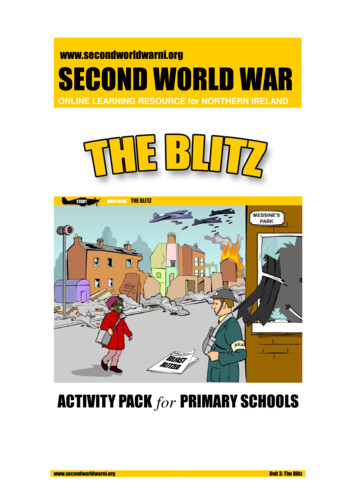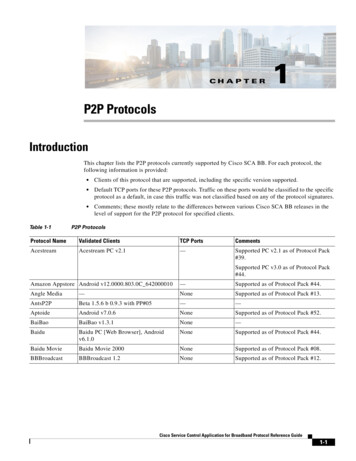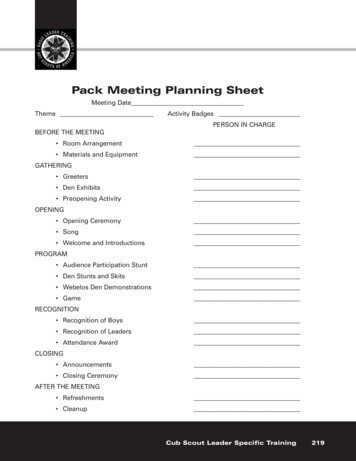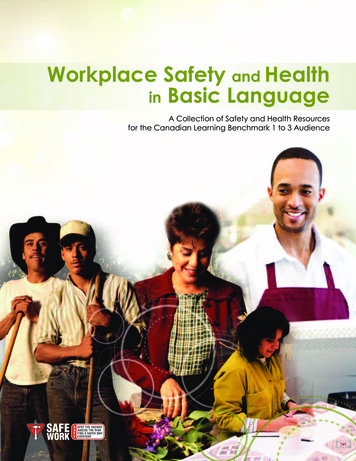
Transcription
www.secondworldwarni.orgSECOND WORLD WARONLINE LEARNING RESOURCE for NORTHERN IRELANDACTIVITY PACK for PRIMARY SCHOOLSwww.secondworldwarni.orgUnit 3: The Blitz
ACTIVITIESPageGas Attack!3Make a Model Gas Mask4-5Air Wardens6Design An Air Warden’s Poster7-8Build a Model Anderson Shelter9 - 10STORY: Parachutes in the Sky11 - 12Blitz Comics13 - 16Radio News Alert!17 - 18War Art19 - 20Animate the Blitz21 - 23Blitz Picture Match24Glossary25www.secondworldwarni.orgUnit 3: The Blitz
Gas had been a deadly weapon in the First World War, so civilianswere issued with gas masks in the Second World War. Gas masks were allocated to eachperson for fear of a chemical attack. Practice sessions were held at school times, althoughin the end the need for gas masks never arose. Special masks were made for babies andeven pets.Explore Gas Masks to see different types of gas masks and to listen to people’sstories about having to wear them when practicing for a chemical attack.Which Disney character is thisgas mask designed to look like?Mickey Mouse, Pluto or Goofey?This picture shows gas masks beingfitted in Bangor. Do you think thatchildren would have found the gasmasks scary or funny?Who’s job was it to distribute the 9,000gas masks to the people of Castlederg?What does this poster tell us aboutMustard Gas?www.secondworldwarni.orgUnit 3: The Blitz
Materials you will need:CardstockBubble wrapCellophane sheetsElastic cordSticky tapeScissorsFront of gas maskBack of gas maskStep 1Print out the Gas Mask Outline onto cardstock and cut out the mask, eyes and nose.Step 2Trace the eye holes onto a sheet of cellophane with a pencil and cut out the circles. Make thecircles you cut out larger than the circle you traced. Tape the cellophane eye holes onto theback of the gas mask, so the sticky tape won’t show when you are wearing the gas mask.Step 3Cut out a long rectangle on cardstock for the mouthpiece. Connect the two ends and tapethem together so you have a cylinder-shaped mouthpiece that is the same size as the mask’smouth. Attach the mouthpiece to the mask with sticky tape.Step 4Cut out a long rectangle on cardstock for the mouthpiece. Connect the two ends and tapethem together so you have a cylinder-shaped mouthpiece that is the same size as the mask’smouth. Attach the mouthpiece to the mask with sticky tape.Step 5Cut out a long rectangle on cardstock for the mouthpiece. Connect the two ends and tapethem together so you have a cylinder-shaped mouthpiece that is the same size as the mask’smouth.Step 6Trace the mouth hole onto a piece of bubble wrap with a pencil or pen. Cut out the circle andtape it to the cylinder-shaped mouthpiece. Attach the completed mouthpiece to the mask withsticky tape.Step 7Punch a hole on either side of your gas mask using a hole-punch. Cut a piece of elastic cordwhich needs to be long enough to use to hold the mask onto your head. Tie both ends of theelastic cord onto your gas mask by making a knot on either end.You have now finished making your model gas mask! Try it on!www.secondworldwarni.orgUnit 3: The Blitz
Gas Mask Templatewww.secondworldwarni.orgUnit 3: The Blitz
Explore Air Wardens then answer the questions.Complete the picture descriptions by filling in the blanks.Air Wardens were the people who sounded the air raidalarms to warn people that enemy p s were ontheir way.This is the badge which air wardens wore. ARP stands forA R P .Air Wardens had many jobs. They reported on air raiddamage to the authorities and advised people in their areahow to minimise their risk of danger during an attack, forexample making sure black out blinds were used andpeople knew how to wear ag m .Air wardens had to make sure that people were followingthe rules of the b . They would have leftthis note at a person’s home if light could be seen from theoutside of the house.An air warden’s first aid case which would have beenused to help anyone who had become injured duringan a r .www.secondworldwarni.orgUnit 3: The Blitz
Explore Air Wardens, The Blackout, Gas Masks, Air Raids and Air Raid Shelters beforedoing this activity.Posters were issued for a variety ofreasons from advice to generaladvertisements or recruiting.This poster contains officialinstructions issued by theministry of Home Security in aneffort to prepare the public in theevent of a gas attack.Your TaskImagine you are an air warden.It is your duty to make sure thateveryone in your area knowswhat to do during an air raid tokeep themselves safe.Make an instructional poster topost up around your town tohelp people prepare for an airraid.Choose ONE of the following posters to design: A poster giving instructions on the correct way to wear a gas mask. If you havemade a model gas mask, why not use a digital camera to take photos for yourposter? A poster explaining what people should do when they hear an air raid siren. A poster reminding people to follow the rules of the blackout.www.secondworldwarni.orgUnit 3: The Blitz
Making Your Poster1. Decide whether you want to draw your poster or use computer software ComicLife or Microsoft Word.2. Decide what pictures you will need for your poster. You can download them fromthe website, take photos using a digital camera, or draw and scan your ownillustrations.3. If you are using the computer to put together your poster, follow these basicsteps: Make a new pageImport your pictures into your page and make them the size you want.Add text to your poster. Remember - the more details you add, the betterprepared people will be for an air raid!Try out different text styles and effects.Experiment with picture effects and picture borders.Put your name on it!Print your poster and pin it up!www.secondworldwarni.orgUnit 3: The Blitz
Anderson shelters were a type of shelter peoplewent into during an air raid to keep safe. Thegovernment gave people an Anderson Shelter kit tofamilies who lived in areas that were expected tobe bombed by German planes.Anderson shelters were built into people’sgardens. They would have been made from sixcorrugated iron sheets which were boltedtogether at the top. They were half dug into theground and dirt was shovelled to cover the topof it. It had an opening for people to climb intoit.Anderson shelters did not have a floor and sowere quite damp, especially if it had beenraining. As there were no lights in the shelterthey were also dark and people had to usecandles or lamps.Materials Needed:Large piece cardboardscissorsCelotapeTwo pieces of grey A4 sized cardA rulerpencilGlueOptional: Decorations and props such as people, treesBuilding Your Model1. Get one of the sheets of card and hold it landscape style. Measure 8 cm from theleft hand side and draw a line at this point down the page. Cut down this line and putthe smaller piece to one side.2. Take hold of the larger piece, hold it landscape again, fold it in half and cut downthe fold.3. Take one of the halves you have just cut and bend it, don't crease it, just make anarch shape.4. Fold the bottom edges in at about 1cm. This makes a flap that will be used to stickonto the base of the shelter.5. Put a bit of glue on the bottom of the two flaps and stick it onto other half of thespare card. Cut off any spare bits of card.6. Get a piece of the card (you may need to use a new sheet of card) and cover oneend of the shelter. Stick this in place. You may find it is easier to use sticky tape forthis. Cut off any spare card.www.secondworldwarni.orgUnit 3: The Blitz
7. Do the same again to the other end of the shelter but cut a little doorway to makethe entrance to the shelter and you have finished!8. Glue your finished shelter onto a large piece of sturdy cardboard.9. Paint and decorate the cardboard to look like a garden. You can paint the top ofthe Anderson shelter to look like grass is growing over it, or use bits of green tissuepaper for grass.10. Add any props such as people, small beds or lamps which might have beeninside for people to use.These pictures show the type of lamps or candles which would have been used in anAnderson shelter. Children’s card games would have been easy to carry into ashelter during an air raid.www.secondworldwarni.orgUnit 3: The Blitz
Bernard McCormack tells a story about the nightwhen his family experienced an air raid in DerryIt was late in the evening when the sirens sounded. My younger brother and I werealready asleep upstairs. My father woke us and told us to come to the kitchen.“You’ll be safer under the table,” he said.My parents were kneeling on the floor and had started to pray. The plane wasrapidly approaching from upriver. The sound of the engines was a surprise to me. Itwas more like and uneven throb than anything else. By this time it was directlyoverhead. The noise was tremendous and truly terrifying to a child. I was convincedit was at a level with the rooftops. Then it swung in the direction of Pennyburn andthe American base. For a brief moment there was silence as the plane’s lethalcargo of landmines drifted towards us on its parachutes. There was a tremendousexplosion, so much so that the very earth shook as the shock waves travelled underground.After the raid many people refused to sleep in their own beds and for several nightsafter. They preferred to take to the hills armed with a bin lid for protection. TheGerman aircraft returned safely to its base in northern France and we children wereperfectly happy the following morning to comb the back lanes of the Waterside forbits of shrapnel.www.secondworldwarni.orgUnit 3: The Blitz
Parachutes in the SkyRead the story ‘Parachutes in the Sky’ then answer the questions.1. What did it mean when a loud siren was heard during the war?2. Where did Bernard’s family hide during the air raid?3. Do you think people were afraid of the parachutes which fell from the sky? Why orwhy not?4. What do you think the German plane was trying to bomb?5. What types of sounds were heard during an air raid?6. How did people try to protect themselves from air raids the next few nights?7. What do you think the ‘shrapnel’ was which Bernard and his friends went lookingfor the next day?www.secondworldwarni.orgUnit 3: The Blitz
In this activity, you are going to bring to lifesomeone’s memory of an air raid by turning it into acomic strip. You can draw your comic or use acomputer to make it. You can use your owndrawings plus photographs from the Second WorldWar website in your comic.Choose ONE of the following blitz stories for your comic.Betty Leathem’s StoryThe night of the big blitz in Belfast we were under the stairs and my little baby brotherwas in one of these great big gas masks that the baby actually sat in. Someone hadto pump the air into it so that was my job. We’d been there for quite a while when mydad came to the door and said, “Come quickly to the door to see something,” and wewent out to the front door and saw the sky completely red where they had droppedbombs on Belfast. It was just such an amazing sight. We couldn’t believe what wewere seeing.David Kerr’s StoryI was eight at the time. Halfway through the night the sirens sounded and we didn’thave any air raid shelters to go to nearby so my mother and my sister and I wentunder the dining room table. My father who was an ARP Warden went out into thestreets to make sure that people’s blackout curtains were working and also to help inany way, putting out any incendiary bombs that might have been dropped.It wasn’t long before the bombs started falling and it was a very frighteningexperience because you didn’t know what sort of effect they were going to have,what damage they were going to do, what was going to happen to us. It went overeventually and we went over into the garden and looked up towards Belfast and thewhole sky was lit up. It was as if the sun had risen in the west.Hugh Giffin’s StoryThe German bombers flew over. You would have seen them on the various raidspassing over there and of course you could see Belfast was burning away. I wascoming up the Station Road and there was a plane coming down.This plane was very low and I looked up at this German plane. And it was so low thatthey were looking down at me and I was looking up at them. And it flew right downthe river. Obviously he had been out at the Atlantic somewhere and was trying to findhis way home so he followed the river down. And about half an hour later when hewas gone the air raid sirens went.www.secondworldwarni.orgUnit 3: The Blitz
Ruby Jordan’s StoryThe first time the siren went off my father was gone. It was just Hugh and me and mymother and my mother was out in the yard. She said, “There’s the fire engine,” andHugh shouted, “No, it’s the air raid sirens!”. So where did we go? Over to aneighbour’s and we all went under her table. But after that when the siren went wenever bothered, you know.Nell Traynor’s StoryThe wardens had a practice night and we’d all have to go up to the air raid shelter inthe bowling green where the car park is now and and wear our gas masks and bringwee plastic cups and bring rocks and all, pretending it was the real thing. But thenwhen the real thing came and all the bombers were coming over the town, and oh thenoise was terrible. Nobody grabbed masks. Nobody ran to the air raid shelters.Nobody ran anywhere.All the people in the bridge end rushed up to the bridge to watch the planes goingover. Standing there with our mouths open waiting on the bombs to come down ontop of them. They weren’t racing to air raid shelters. They were standing in awe‘cause they never seen such a sight in their lives.Chris Wiltshire’s StoryIt was Easter Tuesday night. We were all going to our beds. The siren went as usualas it did nearly every night. My mother put us all into the front bedroom. My father hewas in the ARP and he put on his big heavy black coat and his ARP tin hat and awayhe went. There was a British Legion Hall on O’Connell Lane and that’s whereeverybody went for a cup of tea and that afterwards and he was there in charge thatnight.We were in the bedroom anyway and my brother Dan he was 16 at the time and youcould hear this plane, an unusual plane. You could always hear the planes goingover but you recognised them. He just came into the bedroom and said, “I’m surethat’s a German plane. And just then there was an unmerciful bang.Air Warden Michael Murray’s StoryWe all cam down to the posts and the next thing there was this tremendous “BANG!”“Oh my god”, says I, “this is it starting.” The next thing then there was silence andthen about five or six minutes later – “BANG!” again, another bang. Silence again. Soafter a good hour or half and hour the phone rang and it was to ask for volunteers togo to Messines Park and that there was casualties and a lot of damage. I rememberthere were relations of my own down there, Murray, and when I went to their houseon Bridge’s Terrace, oh my god, the landing window was down at the front door. Thehouse was wrecked. And I enquired and asked a few people where are the Murraysand are they safe enough? Eddie’s out with a pot of tea going around houses givingpeople drinks.The first mine came down. It came down on a parachute. There wasn’t direct bombscoming down. They could have landed anywhere, they were drifting in the wind. Itcome down a big green parachute and landed in his back garden and they werewrecked. The other one came down where Pennyburn Chapel is now, just acrossthere, and didn’t the second mine land in a sandpit and blew a big crater about fortyfoot wide and I don’t know how much deep.www.secondworldwarni.orgUnit 3: The Blitz
Making a Comic BookDrawing A Comic1. Use the ‘Drawing A Comic’ worksheet to draw your comic.2. In the first square, write in the title and your name.3. In the rest of the boxes, write one sentence at the bottom of each box.You may need to use several worksheets.4. Draw a picture for each sentence. See sample comic for an example.5. Staple your comic pages together along the left side.6. Read your comic then share it with friends!Making a Comic on the Computer1. Gather the images to be used in your comic. These can be your owndrawings or photographs taken from the Internet, or a combination of both.2. Any drawings will need to be scanned or take a picture of them with a digitalcamera and then download the pictures to the computer.3. Open the computer software you will use, for example Microsoft Word orComic Life.4. Make a new page and type in a title at the start of the first page.5. Add in your picture boxes and import the pictures in the correct order.6. Use text boxes or speech bubbles to add the narration of your story.7. Add as many pages as needed until your story is completed.8. Format your text’s font, size and colour.9. Add more details or decoration to your comic. This might include changingpicture frames or adding special effects to pictures.10. Save your work.11. Print your completed comic and staple the pages down the left side.www.secondworldwarni.orgUnit 3: The Blitz
Drawing a Comicwww.secondworldwarni.orgUnit 3: The Blitz
ICT Activity: Working with Sound, PodcastingPeople listened daily to the radio to keep informed about what was going on in thewar. In this task you are going to write and record a News Report Podcast about thebombings at Messines Park or the Belfast Blitz.Imagine you are a news reporter reporting on either the bombing of Messines Park inDerry or the Belfast Blitz. Research information about one of the topics and write ashort news report about what happened.When you have written your news report you will then record the report into thecomputer. Music and sound effects can be used to make your news report soundmore powerful.Getting Started – Writing your News Report First collect your facts. Ask the classic questions: Who, What, Why, When,Where and How. Start with a strong lead. Hook your viewers or readers with the most intriguingaspect of a story up front, otherwise they won't bother listening to the rest ofit. Try out different language effects in your opening sentence, for example theuse of puns, play on words, or rhyme. Study good examples of catchynewspaper headlines of big events. Write simply and actively as if you're trying to tell your best friend the latestthat happened today. Take out words that aren’t needed. Try to include as many important details as you can.www.secondworldwarni.orgUnit 3: The Blitz
Radio News Alert!Teacher NotesPodcasting is a great way to support language andcommunication. A podcast is like a radio show. However,instead of being broadcast live, a podcast is recorded andthen distributed over the Internet, so that you can listen to itwhenever you please. There are thousands of podcastsavailable, ranging from general interest entertainment showsto those focusing on specific topics (e.g. music, education).The basic equipment you need is a computer with some kind of recording ability (aninternal or external microphone) and some recording software. Audacity is free andallows you to record your show and then export it as an mp3 file. Music can bedownloaded from the Audio Network PLC website which can be accessed throughLearning NI. You can then upload the recorded podcast to your school website.Easy steps to making a simple podcast1. Determine the nature and content of your podcast. Write the material to beincluded in the podcast.2. Record the audio for your podcast. Free audio software is Audacity. Other goodsoftware includes Mixcraft or GarageBand (Mac only).3. Tag it, give it ID information (Artist, Album) and give it album art. Either make ityourself or find some free, non-copyrighted images online.4. Save the audio file in MP3 format to your computer desktop. Open it up into yoursound editor and edit out extra background noise or long periods of silence. Putin introduction and ending music if you want.5. Upload your MP3 file onto your school’s website or LearningNI to share it withothers.Useful linkshttp://audacity.sourceforge.net/FREE Audacity music software can be downloaded here along with user tutorials.Learning NISearch for Audio Network PLC to access music and sound effects to use in soundprojects.www.secondworldwarni.orgUnit 3: The Blitz
Henry Moore’s War DrawingsThe Artist and Sculptor Henry Moore was an eyewitness to the night-timebombing of London by the German Air Force in 1941 (known as ‘The Blitz’). Inthis work, entitled 'Eighteen Ideas for War Drawings', the artist used colouredcrayons, watercolour wash, pen and ink to sketch out a series of dramaticimages of airplanes, explosions, bomb craters, burning buildings andsearchlights illuminating the night sky. By using the bright colours (red &yellow) against a dark background, the artist has captured a frightening visionof a city and countryside in flames.Can you figure out what is happening in each picture?www.secondworldwarni.orgUnit 3: The Blitz
Studying Henry Moore’s ImagesHaystack & AirplaneThis image shows a Germanbomber lodged against ahaystack. The Artist picturesboth objects from a high angle.He has adopted theperspective of a bomber pilotas he looks down from aboveat the buildings and fields thathis bombs will destroy.Flashes from the GroundThe bombing raids took place under coverof darkness. Searchlights were used tolight up the night sky so that anti-aircraftguns could target the German airplanes.In this image, we can also see the flamesof burning houses and two figures in theforeground, staring at the destruction.Devastated HousesThe impact of the bombs falling from thesky on to streets and houses set off loudexplosions. Other sounds included themachine gun fire of anti-aircraftbatteries, the droning of the planesoverhead and the high-pitched wail ofair-raid sirens.www.secondworldwarni.orgUnit 3: The Blitz
ICT Activity: AnimationYour task is to become a war artist and make a shortanimated sequence which represents the Blitz.This work by Henry Moore resembles a film strip or storyboard for a movie. The artisthas drawn out eighteen separate images that combine together to tell a story aboutthe horror and devastation of war.These photographs show the devastation caused by the BlitzSTEP 1 Getting StartedStudy the artist Henry Moore’s ‘Eighteen Ideas for War Drawings’ to see how heused drawings to show what the war was likeYou can explore the work of other war artists using the internet.STEP 2 What Will You Animate?Answer these questions to help you think of an idea What images come to mind when you think of the Blitz?Hint: Look at Henry Moore’s artwork or photographs taken of cities after theBlitz for ideas. Example: German Bomber PlaneWhat simple movement could you create with this image?Example: German Bomber Plane dropping a bombSTEP 3 Make A StoryboardUse the Animation Storyboard Worksheet to plan what pictures & sound effects youwill use to make your animation.www.secondworldwarni.orgUnit 3: The Blitz
Animation StoryboardMake 5 simple drawings to plan what will happen in your animation1What sound wouldmatch this picture?2What sound wouldmatch this picture?3What sound wouldmatch this picture?4What sound wouldmatch this picture?5What sound wouldmatch this picture?www.secondworldwarni.orgUnit 3: The Blitz
STEP 4 Make Your PicturesThere are 3 ways to make your pictures: You can make 5 separate drawings, makepaper cut-outs, or use real objects!Drawings Draw 5 pictures to show the different stages of the animation. You will needfive A4-sized sheets of paper.These pictures need to be scanned or captured with a digital camera andsaved into your folder on the computer.Paper Cut-Outs Draw a background for your animation on a large sheet of paper. This couldbe a city, country, or just a sky! Your background should not include anyobjects that you want to move.On a separate piece of paper, draw the objects that will move in youranimation, for example a plane, bombs, and flames. Cut them out withscissors.Place the paper cut-outs onto the background as to how they should look atthe start of the animation. Take a picture with a digital camera. Repeatmoving the paper cut-outs and taking pictures until you have taken 5 pictures.Save the pictures into your folder on the computer.Real Objects Draw a background for your animation on a large sheet of paper. This couldbe a city, country, or just a sky! Your background should not include anyobjects that you want to move.Gather the objects that you are going to use, for example a toy plane. Objectscan also be made out of plasticine.Place the objects onto the background as to how they should look at the startof the animation. Take a picture with a digital camera. Repeat moving theobjects and taking pictures until you have taken 5 pictures.Save the pictures into your folder on the computer.STEP 5 Sound EffectsUse the internet to find sound effects. Here are some good sites to look at. You willneed to save the ones you want to use into your folder on the computer.STEP 6 Putting It All TogetherYou can use Movie Maker or PhotoStory to put together your animation. Import yourpictures and sound effects and place them in the correct order. Don’t forget to add atitle and your name at the start! Why not try out some transitions and special effects.You can record Narration and Sound Effects with a microphone. Finally, play yourfinished animation!www.secondworldwarni.orgUnit 3: The Blitz
Match the picture descriptions with the correct picture.Write the letter of the description in the matching picture’s box.a. Belfast’s High Street after Belfast Blitzb. Mickey Mouse Gas Maskc. Air Raid Wardens at Workd. Blackout Blindwww.secondworldwarni.orge. Blackout Lampf. Air Raid Shelters in Belfastg. An Anderson Shelterh. Gas Masks Being FittedUnit 3: The Blitz
Air RaidAn attack by military aircraft, especially when armed withbombs and rockets.Air Raid ShelterStructures for the protection of the civil population as well asmilitary personnel against enemy attacks from the air.Air Raid SirenA device for generating sound to provide warning ofapproaching danger and to indicate when the danger haspassed.Air Raid WardenA person whose responsibility was to defend a particularbuilding during an air raid, ensure the blackout was complete,and to assist civilians to an air-raid shelterAircraftAny man-made vehicle that can fly through the air, such as anairplane, helicopter, glider, or balloon.Anderson ShelterA small prefabricated air-raid shelter of World War II consistingof an arch of corrugated metal and designed to be partly buriedin people's gardens and covered with earth for protectionBlitzThe bombing of British cities in WW II: the intensive bombingof British cities by the German Air Force between 1940 and1941.BlackoutThe extinguishing or concealment of all visible lights in a city,military post, etc., usually as a precaution against air raids.BomberA military aircraft that drops bombs during flightEvacuationTemporary but rapid removal of people from a building ordisaster (or threatened) area as a rescue or precautionarymeasureGas MaskA respirator that contains a chemical air filter and is worn overthe face as protection against toxic gasesMustard GasMustard gas is a chemical weapon that was first used in WorldWar I and causes blistering of the skin.ParachuteA cloth item usually shaped like an umbrella when expanded,and used to slow the falling speed of a person or thingdropping from an airplaneShrapnelPieces from an exploded artillery shell, mine, or bombwww.secondworldwarni.orgUnit 3: The Blitz
Gas had been a deadly weapon in the First World War, so civilians were issued with gas masks in the Second World War. Gas masks were allocated to each person for fear of a chemical attack. Practice sessions were held at school times, although in the end the need for gas masks never










